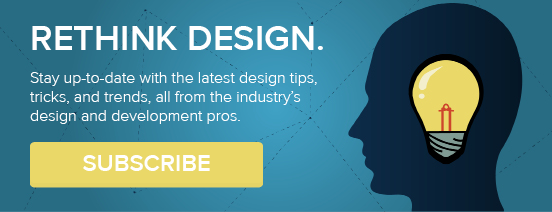The objective of good design is to make life easier.
A poorly designed product causes unnecessary stress, creates frustration, and wastes valuable time. Poorly designed websites elicit the same responses and result in low conversion rates and below average returns on investment (ROI).
An ecommerce web design is not created to serve as a product placeholder; the design is part of the customer service, sales, marketing, and visual merchandising department. If your ecommerce business is not placing importance on ecommerce webdesign, 2015 is the year to do so.
With 2014 nearly over, it’s time to be aware of ecommerce design trends and predictions for next year. To help you prepare, EYEMAGINE’s experienced team of web designers composed a list of the top ecommerce design trends and predictions to be on the look out for in 2015. Properly executing these elements will place your eCommerce business as a forerunner among competitors.
These 4 ecommerce web design trends for 2015 keep new visitors and returning customers engaged by keeping you ahead of the curve.
1. Nearly Flat Design
Google, Microsoft, and Apple have made it clear; flat design is in. While the idea isn’t new, it’s become an increasingly popular design used for ecommerce sites. Expect this trend to continue as its more pleasing to the eye, easier to understand, and easier to develop and make responsive.
The subtle elements of nearly flat design direct the focus towards the content, decreasing the site’s bounce rate. The core principles of skeuomorphism are applied to a digital palette to resemble real life scenarios. Call-to-action buttons have slight gradients to set them apart just enough to say, “I’m a button, you can click me” without screaming, “I belong in a cartoon!”
The same concept applies to drop shadows. It’s possible to bring an element to the front of the screen without making it appear as if it’s floating in outer space. The “less is more” approach to web design will continue to grow in 2015 as there’s a greater focus on the products rather than on background design elements.
2. Micro UX/Transitions
The online shopping experience should be enjoyable, but how do you make that happen? As the saying goes, the devil is in the details. Fun little features you may assume will be overlooked by the average customer actually boost the user experience and have the potential to increase click-through rates. Most micro transitions are unexpected, so the users are surprised by the animation. Great design on ecommerce websites create a friction less experience for visitors, but including micro UX effects and transitions creates a memorable impact.
Implementing these elements throughout an ecommerce site adds to its personality. Hover effects on the navigation bar, such as color change and animation, enhance the online shopping experience by outlining the paths visitors take as they navigate the shop. Some ecommerce sites are including large product images with details displayed as visitors hover over the image. The hover appearance saves space on the site, surprises page viewers, and allows for better product displays. These new and unique features elevate the ecommerce store’s reputation as modern and unique, while keeping visitors engaged.
3. Tiled Navigation
Images are far more captivating and time-saving than text boxes; this is just one reason why tiled navigation is becoming increasingly popular among ecommerce sites. Instead of the standard top navigation bar we’re accustomed to seeing, ecommerce sites are implementing preview in the form of tiles. Using image tiles instead of lists cuts down on the possibility of getting lost and gives users a preview of what they’re going to see.
Not only are high-resolution product images more appealing than text, they’re much more enticing to click through. Your visitors should not navigate away from your site without completing a desired action, whether it’s downloading a free content offer or making a purchase. Tiled navigation has the potential to grab the attention of visitors as soon as they interact with your ecommerce store and keeps them entertained as it recreates the feel of walking into an actual store.
4. Device Agnostic
It’s time to stop designing web pages for particular devices. An ecommerce site must appear and function properly on all screen sizes. Trent Walton refers to the page adaptation as “device-agnostic.” The ecommerce web design must take into account the amount of screen resolution combinations, input methods, browser capabilities, and connection speeds to create the most enjoyable experience for visitors.
Properly responding to every device will allow users to easily navigate through products and complete the checkout process. There is no need for consumers to pinch the screen, click on an undesired button, or to navigate away from frustration. Device-agnostic design will leave visitors wanting to return.
At EYEMAGINE we strive to be on top of the ever-changing ecommerce trends. Being prepared for the future helps us and our partners stay ahead of the competition. If your ecommerce business is not up-to-date with ecommerce design to increase sales, let us help with a FREE ecommerce consultation.






